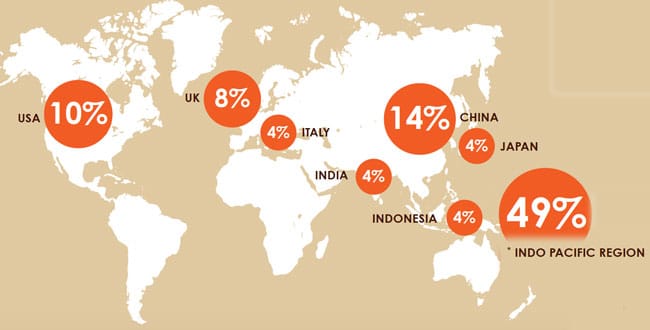Australian students studying abroad more than ever before
One in four (24%) Australian undergraduate students participated in a study abroad learning experience in 2018, up from 22.4% in 2017. Across all levels of study, study abroad experiences were more common in 2018 than in previous years: 18.5% in 2018 versus 17.1% in 2017, 15.9% in 2016, and 13.7% in 2015.
News of this growing trend comes from the Australian Universities International Directors’ Forum (AUIDF), which since 2005 has conducted an annual study in collaboration with i-graduate to measure outbound learning mobility by Australian students. The 2018 study draws on data from 34 universities.
The top five destinations for Australian students were China, USA, UK, Italy and Japan, unchanged from 2017. Indo-Pacific countries host half of outbound Australian undergraduate students.

“An undergraduate phenomenon”
AUIDF reports that of 52,170 study abroad “experiences,” 36,575 were undertaken by undergraduate students. This number dwarfs the numbers for postgraduate coursework students (8,220) and postgraduate research students (7,380). For all students who went abroad, faculty-led study tours were the most popular type of international experience (24%) followed closely by internships or other practical placements (21%).
Study abroad a growing priority for the Australian government and universities
Jo Byng, Director of International Strategy, Mobility and Operations for Western Sydney International, and a member of the AUIDF Executive, told ICEF Monitor that the growth in the Australian outbound market can be “partly attributed to the Australian government placing a high priority on undergraduate student mobility, underpinned by substantial funding support.”
The funding support Ms Byng is referring to is through New Colombo Plan scholarships, grants and OS–HELP loans, the latter which are fee-free, interest-free, HELP-based loans designed to support overseas study. Ms Byng explains that “students are eligible to borrow AUS$6,913 for study outside Asia and AUS$8,295 for study in Asia.”
Ms Byng also noted a trend of universities placing a high priority on increasing learning abroad participation:
“Research into the impact of International study experiences has identified benefits for students, institutions, and communities including enhanced learning, academic success, career prospects, cultural engagement and personal development.”
Outbound trends in other countries
Canada, the destination that most closely mirrors Australia in terms of international education ambitions at the moment, announced a new internationalisation strategy this summer that also puts a high priority on domestic students going abroad. The new priority was spurred by research showing that “approximately 11% of Canadian undergraduates study abroad during their academic career—significantly fewer than students from France (33%), Australia (19%) and the United States (16%).”
Meanwhile in the US, 341,750 American students participated in study abroad programmes in 2017/18, a 2.7% increase over the previous year. The trend toward more outbound mobility is also evident in the UK, where 7.8% of undergraduate students studied abroad in 2016/17 compared with 7.2% the previous year.
For additional background, please see:
















